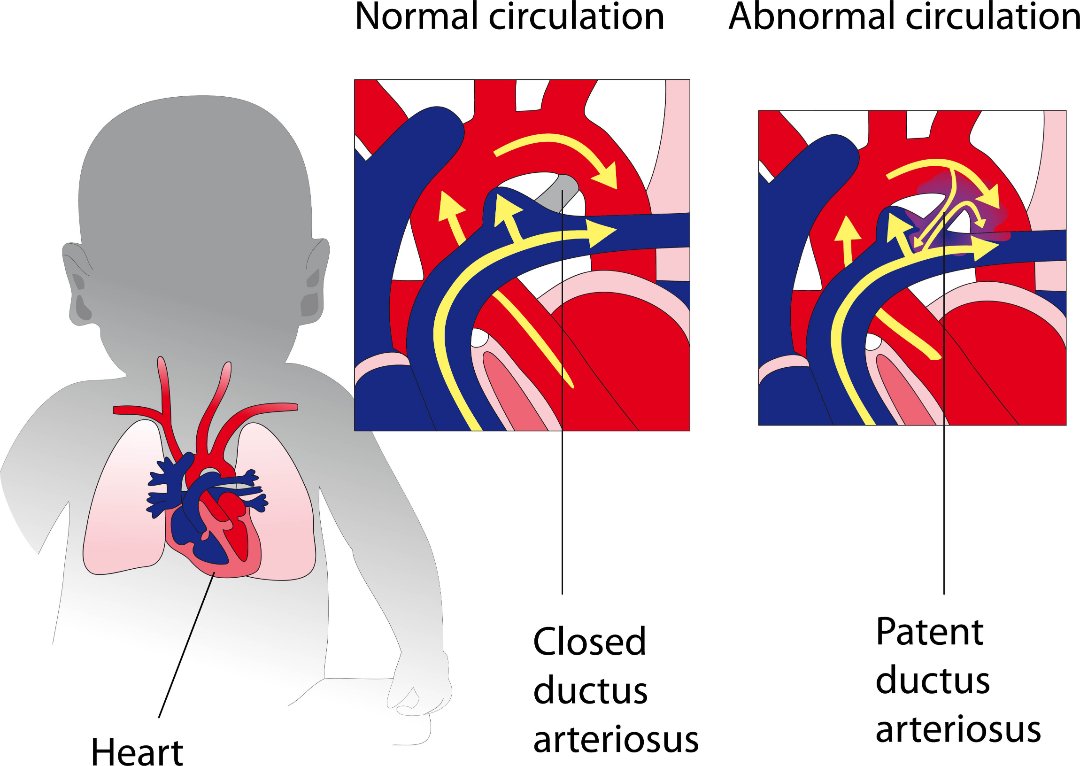Patent Ductus Arteriosus

Patent ductus arteriosus (PDA) is a congenital heart condition in which there is an opening between the pulmonary artery and the aorta. The ductus arteriosus is a small connection in the fetal heart helps oxygen rich blood to by-pass the immature baby’s lungs and flow into the body. This connection naturally closes shortly after birth. The connections that fail to close, are called patent ductus arteriosus, where the oxygen-rich and oxygen-poor combines together resulting in an increase in the workload of heart and various other complications.
It is the sixth most common type of congenital heart disease, and is frequently diagnosed in infants; although it may remain unknown until childhood or even adulthood.

Symptoms:
The symptoms depend on the size of the patent duct and the gestational age of the neonate. A small patent ductus arteriosus can remain unrecognized until adulthood, whereas, a large patent ductus arteriosus may lead to life threatening conditions such as heart failure.
In neonates, a heart murmur on examination with a stethoscope during regular checkup may indicate PDA.
In infants, a large PDA would show the following symptoms:
- Inability or difficulty in feeding, leading to poor growth
- Sweating on crying or eating
- Persistent fast breathing or breathlessness
- Cough
- Lower respiratory tract infections
- Pneumonia
- Easy tiring
- Rapid heart rate
The symptoms in the case of adults with undiagnosed PDA include heart failure, fast heart beating (atrial fibrillation) or with the reversal of shunting – unoxygenated blood from the right side of heart to the left side of heart.
Causes:
In most of the children the cause of PDA is unknown, but genetic factors are thought to play a causative role.
Every baby is born with ductus arteriosus which eventually narrows and closes within three to four days after birth. It may take longer time for closure in the case of premature babies.
But if the duct doesn’t close, it may lead to an increase in the blood flow to the heart and lungs of the baby, which might enlarge or weaken the heart muscle.

Risk factors:
The risk factors of having patent ductus arteriosus include:
- Gender: PDA is more common in girls than in boys.
- Prematurity: It is more common in babies who are born before the gestational term than in full term babies.
- Family history: A family history of heart conditions and other genetic disorders, such as Down’s syndrome may increase the risk of PDA.
- Rubella infection: If the mother is affected with rubella infection during pregnancy, the virus may cross the placenta and spread through the baby’s circulatory system potentially damaging blood vessels and organs including the heart.
- High altitude birth risk: Babies born at altitudes higher than 10,000 feet are at an increased risk.
- Congenital heart problems: Babies with congenital heart problems such as hypoplastic left heart syndrome, transposition of the great vessels, and pulmonary stenosis are at high risk.
Diagnosis:
A heart murmur heard during a regular checkup may lead to further work-up for PDA.
The following tests Are recommended for diagnosis of PDA:
- Chest X-ray to assess the condition of the heart and lungs, and also to rule out other conditions
- Echocardiogram to assess the heart, its valves and chambers for any defects and see if the heart is pumping properly
- Electrocardiogram (ECG) to assess the electrical activity of the heart to diagnose any heart defects or rhythm problems
- Cardiac catheterization to rule out other congenital heart defects found during an echocardiogram or in a case where the catheter procedure is considered for the treatment.

Treatment:
Treatment is generally not considered, as the PDA usually closes on its own in the case of a premature baby. Close monitoring is considered for full term babies, children and adults with small PDA and with no other health complications. During follow-up, if the baby does not have any other complications, it is considered to be closed. On the other hand, if the baby has certain heart problems or defects, the ductus arteriosus might be lifesaving.
In a premature baby, it may take one to two years. But in full term babies, PDA that remains open after several weeks rarely closes on its own.
Medicines such as indomethacin or ibuprofen may be considered. These medicines work well for some newborns. The earlier treatment is given the greater are the chances for it to succeed.
Medical procedures may be considered in the case where medications are not effective.
A transcatheter procedure is used to block blood flow through the vessel. This is usually using an umbrella device that closes the PDA. This procedure does not require general anesthesia and requires hospital stay less than 24 hours.
An open heart surgery might be considered if the catheter procedure is not suitable to repair PDA. This is usually reserved for very large ductus and other associated heart defects.
Prevention:
Patent ductus arteriosus may not be prevented, but certain measures should be observed for a healthy pregnancy.
- Early prenatal care
- Healthy diet
- Regular exercise
- Avoiding consumption of alcohol, illegal drugs and cigarettes.
- Getting vaccinated as recommended.
- Optimal diabetes control.

